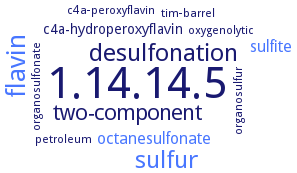1.14.14.5: alkanesulfonate monooxygenase
This is an abbreviated version!
For detailed information about alkanesulfonate monooxygenase, go to the full flat file.

Word Map on EC 1.14.14.5 
-
1.14.14.5
-
flavin
-
sulfur
-
desulfonation
-
two-component
-
octanesulfonate
-
sulfite
-
c4a-hydroperoxyflavin
-
organosulfonate
-
petroleum
-
oxygenolytic
-
tim-barrel
-
c4a-peroxyflavin
-
organosulfur
- 1.14.14.5
- flavin
- sulfur
-
desulfonation
-
two-component
- octanesulfonate
- sulfite
-
c4a-hydroperoxyflavin
-
organosulfonate
-
petroleum
-
oxygenolytic
-
tim-barrel
-
c4a-peroxyflavin
-
organosulfur
Reaction
Synonyms
alkanesulfonate alpha-hydroxylase, alkanesulfonate monooxygenase, AOLE_19265, FMNH2-dependent alkanesulfonate monooxygenase, msuD, oxygenase, alkanesulfonate 1-mono-, Pfl01_3916, SsuD, SsuE, sulfate starvation-induced protein 6, YcbN
ECTree
Advanced search results
Crystallization
Crystallization on EC 1.14.14.5 - alkanesulfonate monooxygenase
Please wait a moment until all data is loaded. This message will disappear when all data is loaded.
molecular dynamics simulations for Ssud in substrate-free form, bound with FMNH2, bound with a C4a-peroxyflavin intermediate (FMNOO?), bound with octanesulfonate, cobound with FMNH2 and octanesulfonate, and cobound with FMNOO? and octanesulfonate
molecular dynamics simulations of wild-type SsuD and variant enzymes bound with different combinations of FMNH2, C4a-peroxyflavin intermediate FMNOO-, and octanesulfonate. Mobile loop conformations are open, closed, and semiclosed. The substrate-free SsuD system has a wide opening capable of providing full access for substrates to enter the active site. Upon binding FMNH2, SsuD adopts a closed conformation. Salt bridges, Asp111-Arg263 and Glu205-Arg271, are particularly important in maintaining the closed conformation. With both FMNH2 and octanesulfonate bound in SsuD, a second conformation is formed dependent upon a favorable pi-pi interaction between residues His124 and Phe261
X-ray characterization, tetramer 96 A x 90 A x 66 A, comprises two homodimers, monomer 60A x 50 A x 40 A, TIM-barrel protein
-
alkanesulfonate monooxygenase unliganded and with a bound flavin and alkanesulfonate, co-crystallization with greater than 5fold molar excess of both ligands, sitting drop vapor diffusion, mixing of 0.001 ml of 8 mg/ml protein solution with 0.001 ml of reservoir solution containing 12-18% w/v PEG 3350, and either 0.14-0.20 M succinate or 0.2-0.3 M sodium acetate set up at room temperature, equilibration againt 0.6 ml of reservoir solution, soaking of crystals in 0.002 ml of reservoir solution supplemented with 2 mM FMN and 2 mM methanesulfonate and 0.001 ml containing MsuD crystals and incubated for over 16 h at 18°C, X-ray diffraction structure determination and analysis at 2.4-2.8 A resolution, ternary-MsuD crystallized in the space group P61 with four MsuD chains per asymmetric unit, arranged as a dimer-of-dimers. In the absence of ligands, MsuD crystallizes in space group P21 with two MsuD tetramers (chains A/B/C/D and E/F/G/H) per asymmetric unit. The active site of MsuD is solvent exposed without FMN bound. Molecular replacement of the unliganded MsuD dataset using the structure of homologue SsuD from Escherichia coli strain K12 (PDB ID 1NQK) as template, modeling
structures of MsuD in different liganded states. The active site of MsuD is solvent exposed without FMN bound. Substrate methanesulfonate is positioned closest to the flavin N5 position, consistent with an N5-(hydro)peroxyflavin mechanism rather than a classical C4a-(hydro)peroxyflavin mechanism. A fully enclosed active site is observed in the ternary complex, mediated by interchain interaction of the C terminus at the tetramer interface. The protein C terminus functions in stabilizing tetramer formation and the alkanesulfonate-binding site. MsuD is a small- to medium-chain alkanesulfonate monooxygenase


 results (
results ( results (
results ( top
top





